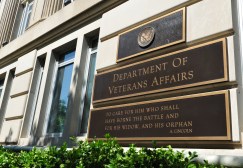VA, DOD show Congress progress in e-health records interoperability
Weeks after a tongue-lashing by a pair of House subcommittees, the officials working on electronic health record interoperability between the departments of Defense and Veterans Affairs say they’ve finally opened lawmakers’ eyes to the progress they’ve been making.
Last week, IT staff from the VA and DOD, as well from the departments’ joint Interoperability Program Office, visited members of Congress to showcase the capabilities of the Joint Legacy Viewer, an interoperable EHR platform that lets the DOD send soldiers’ records to the VA as they move on to veteran status, according to Elaine Hunolt, co-director of the Interoperability Office for the Veterans Health Administration.
In earlier hearings, the two departments described to Congress the progress they’d made on JLV, and the lawmakers mostly met the explanations with ridicule. But they really didn’t grasp the system the agencies’ officials were describing, Hunolt said.
“They all admitted that they hadn’t actually seen the actual successful exchanges we have going on,” she explained Tuesday at the 2015 AFCEA Health IT Day.
It’s the job of officials to make the systems behind what are essentially the nation’s two largest health care providers interoperable — a requirement they failed to meet by the Oct. 1, 2015, deadline established in the National Defense Authorization Act for 2014. But it’s crucial that they also “try to continue to educate members of Congress on what we’ve actually achieved and what these capabilities are,” she said.
“We think even if one person sees that, one individual acknowledges it, that’s a step in the right direction, ’cause we have done a lot of work,” Hunolt said.
Lauren Thompson, director of the Interoperability Program Office, said “we spend a lot of time and effort trying to educate our congressional colleagues on what exists.”
“When they see the capabilities, the light goes on for them,” Thompson said. “We’re trying to really help them understand what it means to be clinicians in that environment and have access to all of that data.
“[JLV] really does enhance the patient experience,” she said.
With the recent progress the VA and DOD have made convincing Congress that the JLV is an in-progress, working solution — and especially now that Frank Kendall, undersecretary of defense for acquisition, technology and logistics, confirmed last month that the two departments have met the requirements of the 2014 NDAA — the battle is anything but finished.
Both behemoth departments are moving to modernized electronic health record-keeping systems — the Defense Healthcare Management Systems Modernization and the Veterans Health Information Systems and Technology Architecture Evolution — that will also have to be interoperable. That challenge, which drew the bulk of the concern from lawmakers during the hearing earlier this fall, must still be overcome.
“Two separate modernizations are a mistake,” Rep. Ted Lieu, D-Calif., said in October.
“We’ve had a lot of concerns about the starts and stops of this,” said Valerie Melvin, director of the Government Accountability Office’s Office of Information Management and Technology Resources Issues, which developed a report in August criticizing the departments’ inability to set strong goals for achieving interoperability. At the same October hearing, she told lawmakers, “It has been a history of the two departments going down particular paths that they wanted pursue for this, changing at certain points, and there has not in our view been the accountability for them doing it.”






